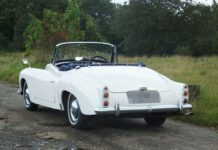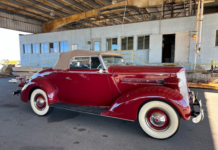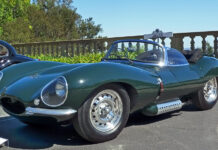We ship quite a lot of classic, collectable and rare cars here at Autoshippers. But there are rare cars, and then there are rare cars, and today we’re going to look at one of the rarest that’s ever passed through our hands: the Thomas Flyer. This is a piece of motoring history that dates back to before the First World War, and it looks simply stunning. Chitty Chitty Bang Bang, eat your heart out!
History
The Flyer was made by the ER Thomas Motor Company. Its founder, Edwin Ross Thomas, started out making add-on gasoline engines for bicycles in 1896. Shortly after that, he founded ER Thomas Motor Company, who were responsible for the Auto-Bi, widely held to be the first production motorised bicycle in the US, as well as the Auto-Tri, a motorised tricycle/three-wheeled motorcycle, and the Auto-Two Tri, a three-seater motorcycle.
In 1902, the company produced its first motor car, the Model 17, which was followed a year later by the Model 18. The first car to bear the ‘Flyer’ name was the Thomas from 1904, a five-seater, steel-framed vehicle with a front-mounted, 24hp straight-3 engine, but the ‘Flyer’ name is more readily associated with the Thomas Model 35.
Launched in 1907, this Flyer became world-renowned when it won the 1908 New York to Paris Race, the first and only round-the-world automobile race ever staged. The driver, George Schuster, completed the 22,000-mile race in just 169 days – that might sound quite a long time now, but bear in mind that this was at a time when most people still believed the motor car to be a newfangled gimmick that would never replace the good old horse and cart, when many roads were unpaved, and when freeways and motorways simply didn’t exist. Indeed, for part of the way they were racing on ice as drivers traversed Alaska, although the original plan to drive across the frozen Bering Strait, the narrow passage of the Pacific Ocean that separates Alaska and Russia, had to be abandoned and the cars were ferried across by boat instead.
Six teams started the race, but only three completed it. A team from German manufacturer Protos of Nonnendamm actually crossed the finish line first, but they were found to have taken several shortcuts, and so first place was awarded to the Thomas team, who finished second. The full story of the 1908 race can be found on The Great Autorace Of 1908 website, while the actual winning vehicle can be seen at America’s National Automobile Museum in Reno, Nevada. This car was closely examined by Schuster himself in the 1960s, and he confirmed that – much to his amazement – it was definitely the same car he’d raced in over 50 years previously! It’s a rather touching story which you can read more on here.
Sadly, despite the Flyer’s success, the ER Thomas Motoring Company went into receivership in 1912. Manufacturing continued for a few more years under the ownership of steel magnate CA Finnegan but ceased for good in 1919.
How to Get Your Hands on One..
If you’ve now set your heart on owning a Thomas Flyer, then we’d respectfully suggest that most people reading this aim for something a little more realistic – like a unicorn, or perhaps simply a Ford Ka made from solid gold with unobtanium wheels! The Flyer is incredibly rare, and hence staggeringly expensive: Sotheby’s, for instance, last sold one in 2015 for £330,000, while prices at US auctions have been known to reach over $730,000!
Still, lottery wins do happen, and if one does, you could be owning a piece of motoring history… and one you’d definitely have no trouble spotting in a supermarket car park!
Here’s a Thomas Flyer shipped by Autoshippers last August (2018):
We hope you enjoyed our Closer Look at the Thomas Flyer! Keep an eye out for more on our blog or check out the rest of our interesting shipments series. And of course, if you’re shipping a car (whether it be a classic or family car) get in touch today or get a .











